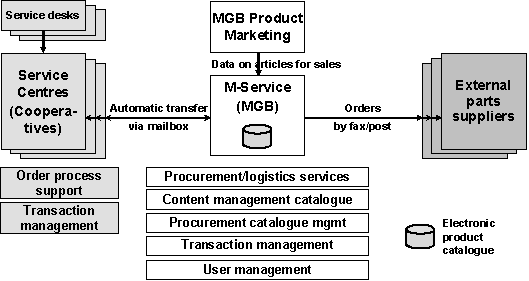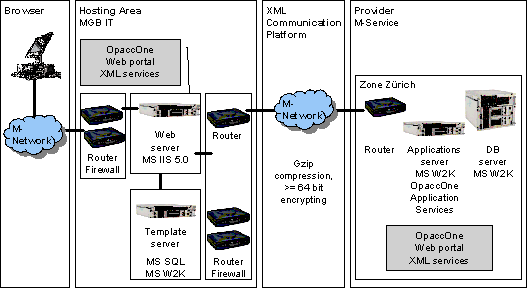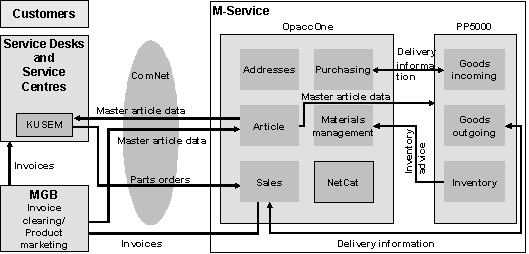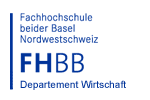Parts management at the Migros Cooperative Alliance
Migros, Switzerland’s biggest retailing company, offers its customers a comprehensive service. This case study describes the organisation of the procurement process for parts from the supplier to the end customer. This process is managed by the procurement service provider M-Service aided by integrated information systems. An electronic multi-supplier catalogue deserves special mention: it clearly raises the efficiency and effectiveness of parts procurement.
1. The company
Background to the Migros company
Gottlieb Duttweiler founded Migros Aktiengesellschaft in 1925. The company philosophy of what was then a mobile shop envisaged a limited range offered at the lowest prices. By 1926, Migros had already opened its first shop in Zürich. Its reorganisation into regional cooperatives and the founding of the Migros Cooperative Alliance (MGB) came in 1941. In 1948, the first self-service shop in Switzerland was opened and in 1998 the Berne and Zürich cooperatives introduced online shopping.
Today, the Migros Group is made up of a number of divisions. Its core business are formed by the “orange Migros”, including supermarkets and superstores, specialised discount stores and speciality shops. Other industrial enterprises belong to the group (e.g. Bischofszell Nahrungsmittel, Chocolat Frey, Mibell, Midor, Seba Aproz) and a range of service businesses (e.g. Limmatdruck, Migrol, Migrosbank, Hotelplan-Gruppe). MGB, moreover, has a majority shareholding in the Globus Trading Groups (Interio, Office World, Herren-Globus and others). Migros is also involved in adult education and culture, recently adding leisure and sport to its activities.
In 2001, the Migros Group produced a consolidated turnover of CHF 20 billion – up 2.6 per cent on the previous year. The share of retail sales is almost 80 per cent. These figures make Migros the largest retailer in Switzerland. Group profits for 2001 were CHF 285 million, the trading profit (EBIT) was CHF 488 million. The Migros Group employs a workforce of 80,000, 1644 of whom work for MGB. The membership of the cooperative grew in 2001 to around 1.9 million.
Industry, markets and target group
In 2001 the retail trade in Switzerland grew by a nominal 1.9 per cent. Today, the market is dominated by a few large firms. Migros’ closest rival is Coop. The small market growth has led to an intensification of competition, a battle initially fought principally through price. Today, strategies based on qualitatively high-grade, innovative and ecological products are gaining in importance.
Migros has achieved a market share of almost 24 per cent in food retailing and 9.5 per cent in the non-food sector. Altogether, Migros’ market share in the retail trade is 16 per cent. Since 2000, a slight buoyancy has again been noticeable.
In order to fulfil individual customer needs, Migros pursues a clear marketing-type strategy in its core business: Its supermarkets (local and regional supply) and superstores (supraregional shopping centres also featuring broad non-food ranges such as clothing, toys and electronics) offer a creative food offering enhanced by essential consumer goods. Customers are made aware of the added health value of fresh products. Discount stores featuring a specialised non-food range (Do it & Garden, Micasa, Sportxx, OBI) have a separate presence.
As a condition to realising its strategies, Migros has developed wide-ranging quality, price, innovative and ecological competencies. Commodity control sets particular store by the focus on processes along the entire value chain. The reorganisation of national logistics serves as an example of an important strategic measure.
Company vision
The Migros Group is committed to people: “Migros contributes to the population’s quality of life by serving its customers with healthy products at reasonable prices.” (Migros 2001 Annual Report, p. 10).
Against the backdrop of this vision and corporate strategy, in which customer focus is accorded the highest priority, the role of Migros’ service organisation treated here is also prominent. The customer care system is designed to be competent, fair and customer-facing. Its services should ensure customer satisfaction and thus promote customer relations. A comprehensive repair service also contributes considerably to the products’ environmental compatibility. Repairs represent an important measure in maintaining value and conserving resources.
The M-Service service organisation
The observations in the remainder of this case study focus on M-Service, a division of MGB. MGB is a subsidiary of the ten Migros cooperatives and performs central functions for them. It forms the link to the industrial enterprises in the group, its service companies and the Globus Group.
M-Service is Migros’ service organisation. Its function lies chiefly in providing parts management for the eight Migros service centres operated by the ten Migros cooperatives. The service centres, meanwhile, run 435 service desks as well as service centres for bicycles, skiing and skating equipment. The service desks offer Migros customers guidance and a comprehensive repair and parts service for all hard goods sold by Migros.
Every year, the service centres process some 800,000 customer orders via the service offices. They achieved turnover of over CHF 50 million in 2001. Excluding the staff at the service offices, the service centres employ 410 personnel units (full-time equivalent).
In order to plan cross-company processes as efficiently as possible – from the parts manufacturer to the decentralised service centres and on to the customer – M-Service has taken on central functions. Its activities include the global procurement of parts (main emphasis), stock management, as a “logistics hub” for repairs and parts orders and in provisioning and maintaining information and logistics systems.
M-Service takes 4000 orders from the service centres annually, corresponding to some 95,000 closed-out positions. The parts centre has 25,000 parts with 11,700 incoming goods every year. With 22 personnel units, M-Service has achieved annual turnover of CHF 5 million from its sales of parts to the service centres.
Since 1999, M-Service has operated an electronic product catalogue which supports the service centres in procuring parts needed for repairs and by customers. The product catalogue forms the focus of this case study and will be explained in detail in later chapters.
2. E-business strategy
In 1999, Migros adopted a group-wide IT strategy that has since been implemented. The strategy’s main component is the standardisation of IT systems at the Migros cooperatives, MGB, the distributors and the industrial concerns.
Initially, Migros aims to gather experience from its e-business activities. Its focus of interest is on new forms of buying and consumption patterns. The projects should show how an operational advantage can be derived. In the area of e-commerce, the strategic significance of surfaceless sales is in the forefront. The e-business strategy is a component of the corporate strategy for Migros’ core business (“orange Migros”).
Because of the division of responsibility between the cooperatives and MGB, almost all web solutions are part of MGB’s remit. In concert with the market-type strategy, each marketing type is provided with its own, tailored intranet and extranet solution. Migros’ production and service operations also have an internet presence.
Internally, the new technologies in the e-business field should serve as bridges and simplify and intensify communication between the various divisions along the value chain. This level can be assigned to the buying process described here.
The e-business strategy of a large enterprise such as Migros is complex and, depending on the division, pursues a wide range of goals. The following e-business vision can be formulated in unison with the company’s goals:
The deployment of e-business at Migros should raise productivity along the entire value chain. Customer frequency and sales should be raised by e-commerce.
3. Procurement solution
E-procurement in the Migros service divison is an internal group solution. M-Service acts as the procurement service provider. The NetCat solution was developed and put into service to provide end-to-end support in the procurement process starting at the service desks. As a browser-based sell-side application, it covers all functions in the order process. At the time of writing this case study, not all the application’s functions were in use despite the fact that the conditions for this were already in place on M-Service’s side. Once they have extracted the articles they need in NetCat, the service centres use a decentralised legacy system linked by interface to M-Service’s ERP system to record and trigger the actual orders. Fig. 3.1 shows how this interaction was organised in mid-2002.
Partial solutions in the procurement solution illustrated are already integrated at the technical level but not, however, into the underlying processes. The following chapter first describes the transaction-oriented part of electronic processing in procurement processes before explaining the electronic multi-supplier catalogue that forms the actual heart of the e-procurement solution. A brief discussion of the partners participating in the solution concludes the chapter.

Fig. 3.1 Distribution of basic e-procurement functions
Functions and processes
Centre-stage in the overall e-procurement solution is the OpaccOne ERP system and the electronic multi-supplier catalogue NetCat (details follow in the section on the electronic multi-supplier catalogue). The ERP system takes on a large share of data-keeping and, together with other systems, controls the primary value creation processes between M-Service at the centre and the decentralised service centres. Fig. 3.2 illustrates the systems involved and the internal Migros process of parts procurement described in this chapter.
Parts orders are input into the KUSEM Migros customer-service information system of each service centre from the terminals at the service desks. The staff locate the necessary information on the parts chiefly using a browser-based search in NetCat. Orders are transferred to the sales module of the OpaccOne ERP system via ComNet, Migros’ internal communication network. This module sends an online order to trigger delivery to the Kardex PP5000 warehousing subsystem which registers incoming and outgoing goods at the central warehouse. The warehousing subsystem in turn produces a confirmation message, later advising of the goods’ successful dispatch. The service centres use the “delivery lists” function in NetCat to find out about imminent goods receipts.
The ERP system also generates the invoices for inter-company billing services between M-Service and the service centres. They are first transmitted electronically to a clearing centre at MGB and then to the cooperatives’ accounting system. Legal requirements at the time the system was introduced dictate that the invoices are additionally sent as hard copies to the cooperatives. Finally, the service centres generate the invoices for end customers in KUSEM.
Orders for procuring parts from suppliers are processed by the ERP system’s procurement module. As a rule, the orders themselves are sent by fax interface. Information about ordered parts is transmitted to the warehousing subsystem from where information about incoming deliveries is sent back to the ERP system. The online connection between the ERP system and warehousing subsystem mean that information about incoming goods is immediately available in the ERP system as well. The ERP system is also responsible for further tasks of procurement management such as demand assessment, forecasts and arrears management.
The master article data for parts and devices is also maintained by the ERP system. The data is regularly transmitted to KUSEM and the warehousing subsystem to ensure that it is available for parts orders.
The described processes between M-Service and the service centres, such as order transfer, order advice, goods incoming, settlement etc. are performed electronically by and large, without any manual post-editing or duplicate checks. The electronic integration of processes and subsystems puts M-Service in a position to process a great many deliveries to the service centres with a minimal workforce.
Electronic multi-supplier catalogue
An important subsystem supporting the parts procurement process is NetCat, the electronic online catalogue. This is an integrated multi-supplier catalogue that makes selecting the correct parts much easier for service-centre staff. The catalogue list all parts carried by Migros as well as the products to which the parts apply. A technical clerk decides which products and parts appear in the catalogue.
NetCat replaced the physical microfiched parts catalogue previously in use. A significant disadvantage of this catalogue was that it was never up to date and that searching for parts was relatively time-consuming.
NetCat gives the staff of the service centres and the service desks a very comfortable catalogue system that enables quick access to the entire and permanently updated Migros parts range. Special search functions facilitate searches for complete products and individual parts. In detail, the catalogue supplies the following information and functions:
- Full-text and structured searches for products and parts
- Identification of parts using images, exploded views and parts lists.
- Order numbers, stocks and delivery times for parts
- Warranty periods, service times, repairs (by Migros or manufacturer)
- Proof of parts’ use
- Instructions on handling repairs
As a subsystem of OpaccOne, NetCat has access to all data in the ERP system. The images in the catalogue are largely from MGB Product Marketing, which maintains a database of product images. Preparing the electronic exploded views by hand is very time-consuming. As a rule, the manufacturers’ drawings are scanned and the individual positions linked to detailed information. Some of this information must be compiled from parts lists or other manufacturer documentation.
By selecting the parts, the service-centre worker creates an order-related parts list. Besides the part numbers and other details, it contains the supplier’s ID and the parts’ selling price. The orders to M-Service are then generated in KUSEM from this parts list. There was still a media interruption at this point in mid-2002 because the order data was input into KUSEM manually.
With an eye to further integration of the order process, it is planned to trigger the order directly via NetCat in the OpaccOne sales module (concept for a sell-side solution). This would be technically possible at M-Service’s end since the order-related parts lists in the background is at the same time an order. This would mean orders would no longer need to be generated in KUSEM. The orders triggered directly in OpaccOne, meanwhile, could be transferred to KUSEM, which is already prepared. With regard to the future development of the electronic catalogue, Migros is now considering making it available to end customers.
A log file analysis has revealed that a year ago around 1100 search queries were made per day to NetCat. That figure is now some 1800. The catalogue’s acceptance is thus very high and its significance in parts management is rising. In future, a log file analysis will help determine which search terms are entered by staff.
Partners
As a large company, MGB has a central IT division that also functions as a partner to M-Service and takes on a range of tasks. The sole external partner in connection with the e-procurement solution described is Opacc Software AG, Kriens. Opacc offers its standardised OpaccOne ERP system and developed the NetCat electronic product catalogue as an extension to OpaccOne. M-Service, having used OpaccOne since 1996, knows this partner well.
M-Service and Opacc designed the NetCat solution together. M-Service created the basic layout that was developed and realised by Opacc. Migros provided the content.
4. Implementation
Development of the electronic product catalogue
The trigger to the development of an electronic multi-supplier catalogues was dissatisfaction with the original parts catalogue. The new solution would be kept updated and be cheaper – and above all, offer the service centres an improved tool. First, some traditional applications, such as document-management and archiving systems, were evaluated. It quickly became clear that these options did not meet all the requirements and had to be discounted.
The subject of the intranet was next considered. Contact was made to Information-Factory, part of Migros subsidiary Limmatdruck. Information-Factory designed a web-based parts catalogue with simple search functions. It began operating in 1997. The content was gradually developed before the switch was made from microfiche to the electronic catalogue. This had the advantage that users could easily adjust, becoming familiar with the new system step by step.
In 1997/98, in its search for a catalogue for better functionality, M-Service approached Opacc. Initially, Opacc viewed web applications with a certain reserve. Then, however, based on the existing catalogue solution, Opacc developed the NetCat electronic catalogue specially for Migros as an add-on to the OpaccOne ERP system. The conversion to the new platform was made in August 2001.
The new NetCat catalogue has a number of advantages: the data is even more current because the catalogue is coupled with the ERP system’s database. This reduces the time needed for data interchange and upkeep. Thanks to its structured searches and proof of parts’ use, NetCat offers users more comfort, too. Additional information on repair execution have also contributed to a clear reduction in the number of erroneous orders and hence to an increase in customer satisfaction. Internally, the new catalogue addressed additional user groups: it offers information to Product Management, technical clerks and the service-centre management.
Software
The basis of the electronic product catalogue is the OpaccOne ERP system that M-Service has used for some years already. OpaccOne is based on a third-generation multi-tiered software architecture, The upper tier, and thus the interface to the user, is made up of back office and front office applications. Java interfaces provides all available functions (“full-featured”) for the back office area (purchasing, sales, inventory management). A task-oriented web interface is available for the front office area (web portal, NetCat) that only gives user a limited selection of information.
All interfaces access the OpaccOne application services via a common access navigation system. The latter forms the common and standardised basis of all OpaccOne applications. The OpaccOne application services are based on the standardised COM/DCOM/COM+ process for Windows applications and ASP (active server pages) for web applications. Thanks to these standards, the OpaccOne applications services are also available to third-party applications.
The application services create the connection to the central Dataflex database. It forms the physical data-storage level.
The NetCat electronic product catalogue comprises a collection of XML templates that control the solution’s views and navigation. The templates are processed a web portal – a COM application within the Microsoft Information Services (MS webserver). The templates were created by Opacc. They are not modified by M-Services.
Technical platform and architecture [system architecture]
Fig. 4.1 shows the technical components of the electronic product catalogue. The user access the OpaccOne web portal via the internal Migros network. MGB’s own IT division is provides the web and template server hosting. The system is protected against unauthorised access by several firewalls. The application server creating access to the application services in the OpaccOne ERP system is operated by M-Service itself. The same applies to the database server.

Fig. 4.1: Hardware architecture
5. Benefits and costs of the multi-supplier catalogue
Against the background of somewhat restrained development on the market for e-business solutions, the question of profitability of e-business projects is raised again and again. Hence, the following chapters will juxtapose the cost and benefit effects of the multi-supplier catalogue described and compare them with the declared objectives.
Benefits
The switch to the NetCat electronic catalogue meant that Migros’ customer service were able to introduce a number of improvements that were not foreseeable as things were. The most important effects include:
Simplifying handling when ordering parts
Since it was often not possible to identify the requested part at the service desk before the introduction of the electronic catalogue, sample parts or whole devices would quite often be dispatched to the service centres. If the customer did not have a sample , he had to come back a second time. With the new catalogue, parts can be uniquely and quickly identified, leading to a clear reduction in time spent handling parts and a cut of half in throughput times.
High price transparency for customers
A large disadvantage of the old catalogue was that it did not contain the selling price. The reason for this were the frequent price changes. It also meant that customers could not immediately find out the price of a repair or a part, which frequently caused annoyance. Today the customer is provided with all the information needed to decide for and against a repair order directly at the service desk.
Doubling of customer orders
Within five years of introducing NetCat, the number of customer orders (parts orders) doubled from 120,000 to 257,000 a year. The outturn of goods by M-Service rose from 1.2 to 2.6 million articles in the same period. The reason for customers’ greater readiness to give a repair order is the better information situation. Customers who decide against a repair are as a rule still satisfied with the service and generate new turnover by making a new purchase at Migros.
Cost savings in the service centres
Staff cuts of around three per cent could be achieved through NetCat. Above all, maintenance of the microfiche in the service centres was no longer a cost factor. Further savings could be made by the reduction in erroneous orders and in the parts warehouse. Thanks to the improved quality of information the waiting times at the desks and the stress factor for service staff were reduced.
Improvement in repair planning
The advice from the warehousing system makes the availability of the part known at a very early point. This means that repairs can be planned far earlier and more precisely.
Costs
Annual costs totalling CHF 120,000 went on the production of the microfilms, divided equally between the service centres and MGB. Today server operation, write-offs and maintenance measures are responsible for annual costs of around CHF 50,000. These costs are borne by MGB. The development of NetCat cost some CHF 50,000.
The production of microfilms required 2.5 personnel units. Now, 1.8 personnel units are required to maintain NetCat. A further 1.5 personnel units take care of further service functions in the parent M-ServiceNet. A great personnel outlay resulted earlier because of the double entry of master data. Today, the main work is in scanning and linking the exploded views.
Profitability
The operating costs for MGB are about the same as they were before the introduction of the NetCat solution. For the service centres, costs have been reduced by around CHF 60,000 a year. It should be noted that the number of parts orders has doubled since the appearance of NetCat so that the reduction in costs per order is even greater.
The qualitative benefits of NetCat and its intuitive user interface and constantly updated, high-grade information are much higher than they were with the microfiched catalogue. The positive effects on dialogue with customers has also improved customer satisfaction enormously. The product catalogue thus fulfilled the requirements formulated in the overarching corporate objectives.
6. Success factors
Many factors and circumstances generally dictate the success or failure of complex projects to introduce information systems. Mostly it is the combination of these factors and circumstances that decide a project’s success. In the case of the Migros multi-supplier catalogue as a component of an integrated procurement process, the following success factors were observed:
- the integration of the electronic product catalogue into the procurement process
- the catalogue’s automatic integration into the OpaccOne ERP system
- the solution’s clearly evident benefits for users
- the low project complexity due to the slight changes to underlying processes and development on a prototype
- the users’ involvement in the system concept
- the partners’ cooperative problem-solving, known and trusted for many years
- the organisation’s readjustment to the system
The project was a success for both Migros and its partner Opacc. It shows that positive effects can be achieved in e-business by deploying the corresponding expertise and the right technology with relatively simple solutions.





